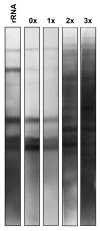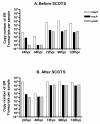Innovative approach for transcriptomic analysis of obligate intracellular pathogen: selective capture of transcribed sequences of Ehrlichia ruminantium
- PMID: 20034374
- PMCID: PMC2806407
- DOI: 10.1186/1471-2199-10-111
Innovative approach for transcriptomic analysis of obligate intracellular pathogen: selective capture of transcribed sequences of Ehrlichia ruminantium
Abstract
Background: Whole genome transcriptomic analysis is a powerful approach to elucidate the molecular mechanisms controlling the pathogenesis of obligate intracellular bacteria. However, the major hurdle resides in the low quantity of prokaryotic mRNAs extracted from host cells. Our model Ehrlichia ruminantium (ER), the causative agent of heartwater, is transmitted by tick Amblyomma variegatum. This bacterium affects wild and domestic ruminants and is present in Sub-Saharan Africa and the Caribbean islands. Because of its strictly intracellular location, which constitutes a limitation for its extensive study, the molecular mechanisms involved in its pathogenicity are still poorly understood.
Results: We successfully adapted the SCOTS method (Selective Capture of Transcribed Sequences) on the model Rickettsiales ER to capture mRNAs. Southern Blots and RT-PCR revealed an enrichment of ER's cDNAs and a diminution of ribosomal contaminants after three rounds of capture. qRT-PCR and whole-genome ER microarrays hybridizations demonstrated that SCOTS method introduced only a limited bias on gene expression. Indeed, we confirmed the differential gene expression between poorly and highly expressed genes before and after SCOTS captures. The comparative gene expression obtained from ER microarrays data, on samples before and after SCOTS at 96 hpi was significantly correlated (R2 = 0.7). Moreover, SCOTS method is crucial for microarrays analysis of ER, especially for early time points post-infection. There was low detection of transcripts for untreated samples whereas 24% and 70.7% were revealed for SCOTS samples at 24 and 96 hpi respectively.
Conclusions: We conclude that this SCOTS method has a key importance for the transcriptomic analysis of ER and can be potentially used for other Rickettsiales. This study constitutes the first step for further gene expression analyses that will lead to a better understanding of both ER pathogenicity and the adaptation of obligate intracellular bacteria to their environment.
Figures





Similar articles
-
Comparative Transcriptome Profiling of Virulent and Attenuated Ehrlichia ruminantium Strains Highlighted Strong Regulation of map1- and Metabolism Related Genes.Front Cell Infect Microbiol. 2018 May 15;8:153. doi: 10.3389/fcimb.2018.00153. eCollection 2018. Front Cell Infect Microbiol. 2018. PMID: 29868509 Free PMC article.
-
Development of a Quantitative PCR Assay for Differentiating the Agent of Heartwater Disease, Ehrlichia ruminantium, from the Panola Mountain Ehrlichia.Transbound Emerg Dis. 2016 Dec;63(6):e260-e269. doi: 10.1111/tbed.12339. Epub 2015 Mar 24. Transbound Emerg Dis. 2016. PMID: 25807955
-
A new typing technique for the Rickettsiales Ehrlichia ruminantium: multiple-locus variable number tandem repeat analysis.J Microbiol Methods. 2012 Feb;88(2):205-11. doi: 10.1016/j.mimet.2011.11.011. Epub 2011 Nov 29. J Microbiol Methods. 2012. PMID: 22143037
-
Heartwater--Ehrlichia ruminantium infection.Rev Sci Tech. 2015 Aug;34(2):557-68. doi: 10.20506/rst.34.2.2379. Rev Sci Tech. 2015. PMID: 26601456 Review.
-
Ehrlichia ruminantium infection (heartwater) in wild animals.Trends Parasitol. 2002 May;18(5):214-8. doi: 10.1016/s1471-4922(02)02251-1. Trends Parasitol. 2002. PMID: 11983602 Review.
Cited by
-
Selective Capture of Transcribed Sequences: A Promising Approach for Investigating Bacterium-Insect Interactions.Insects. 2012 Mar 2;3(1):295-306. doi: 10.3390/insects3010295. Insects. 2012. PMID: 26467961 Free PMC article. Review.
-
Global changes in gene expression by the opportunistic pathogen Burkholderia cenocepacia in response to internalization by murine macrophages.BMC Genomics. 2012 Feb 9;13:63. doi: 10.1186/1471-2164-13-63. BMC Genomics. 2012. PMID: 22321740 Free PMC article.
-
Comparative Transcriptome Profiling of Virulent and Attenuated Ehrlichia ruminantium Strains Highlighted Strong Regulation of map1- and Metabolism Related Genes.Front Cell Infect Microbiol. 2018 May 15;8:153. doi: 10.3389/fcimb.2018.00153. eCollection 2018. Front Cell Infect Microbiol. 2018. PMID: 29868509 Free PMC article.
-
Non-coding RNA regulation in pathogenic bacteria located inside eukaryotic cells.Front Cell Infect Microbiol. 2014 Nov 12;4:162. doi: 10.3389/fcimb.2014.00162. eCollection 2014. Front Cell Infect Microbiol. 2014. PMID: 25429360 Free PMC article. Review.
-
Next-Generation Sequencing Approaches in Genome-Wide Discovery of Single Nucleotide Polymorphism Markers Associated with Pungency and Disease Resistance in Pepper.Biomed Res Int. 2018 Jan 9;2018:5646213. doi: 10.1155/2018/5646213. eCollection 2018. Biomed Res Int. 2018. PMID: 29546063 Free PMC article. Review.
References
-
- Alland D, Kramnik I, Weisbrod TR, Otsubo L, Cerny R, Miller LP, Jacobs WR Jr, Bloom BR. Identification of differentially expressed mRNA in prokaryotic organisms by customized amplification libraries (DECAL): the effect of isoniazid on gene expression in Mycobacterium tuberculosis. Proc Natl Acad Sci USA. 1998;95(22):13227–13232. doi: 10.1073/pnas.95.22.13227. - DOI - PMC - PubMed
Publication types
MeSH terms
Substances
LinkOut - more resources
Full Text Sources

